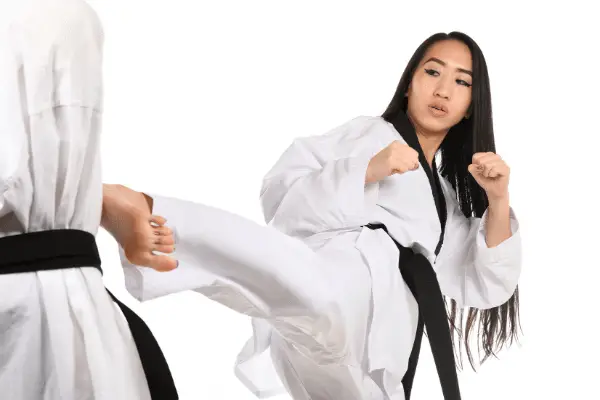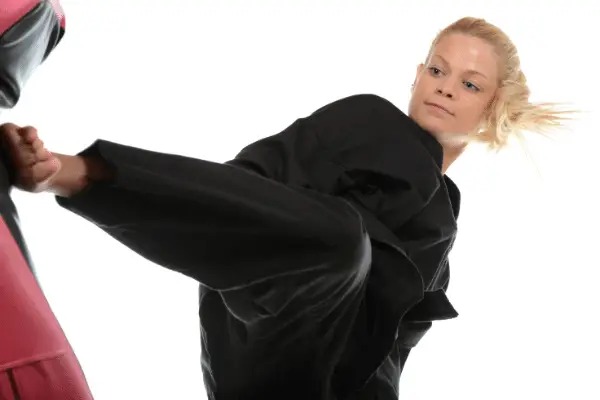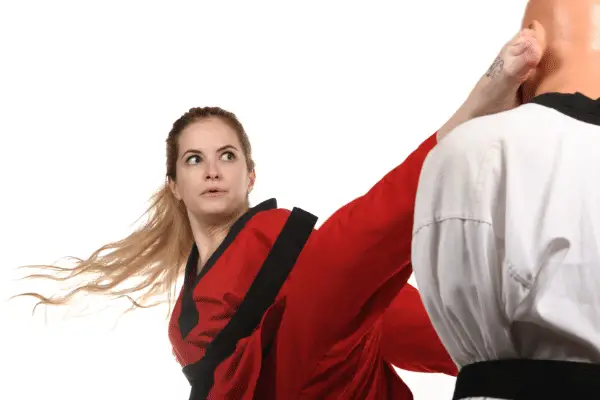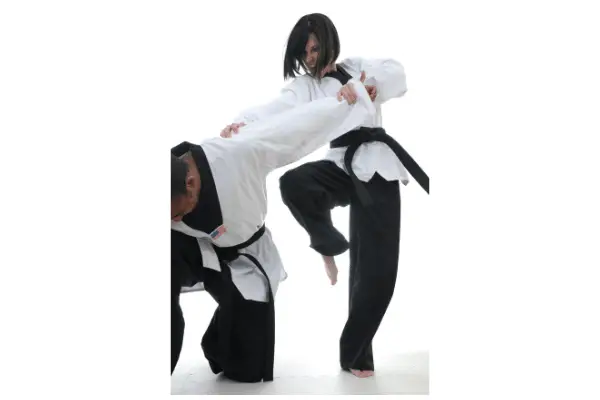Although there are punches and other strikes in Taekwondo, The primarily focused of Taekwondo is on kicks.
The set of different unique and efficient kicks make Taekwondo different and unique from other fighting styles.
Taekwondo is a Korean fighting style which is derived from Karate – Japan – and Chinese Martial arts, but basically, it is based upon the Korean native fighting styles named Taekkyon, Gwonbeop, and Subak.
Driven from a lot of disciplines, Taekwondo mostly extracted the kicks.
There is a thought that Taekwondo was used by the South Korean Army personals so they only focused on kicks because hands would have to carry a gun.
So while having a gun in their hands, a person’s hands are bound but his legs are free to move. The main concentration of Taekwondo is head-high kicks to destroy the opponent’s chin or jaws or making them unconscious by landing a well-timed kick to the temple.
Since Taekwondo is a Korean fighting style, we will describe kick names with their Korean pronunciation too. In the Korean language, kicks are called “Chagi”. Let us have a look at the famous kicks in Taekwondo.
Disclaimer: These kicks or any other material provided on this website is for informational and educational purposes only. We encourage our readers to learn the fighting art from authentic and certified coaches only and never try any kick, punch, joint lock, or air choke at home. There are sparring sessions to practice what one learns.
List of the most famous kicks on Taekwondo
- The “Ap Chagi” or The Front Kick
- The “Dollyeo Chagi” or The Roundhouse Kick
- The “Huryeo Chagi” or The Round Hook
- The “Dwit Chagi” or The Back kick
- The “Yeop Chagi” or The Side Kick
- The “Bandae Yeop Chagi” or The Reverse Side Kick
- The “Bandae Dollyeo Chagi” or The Reverse turning Kick
- The “Kawi Chagi” or The Scissor Kick
- The “Mureup Chagi” or The Knee Strike
- The “Twi Myo Yeop Chagi” Or The Flying Back Kick
- The” Twi Myo Yeop Chagi” Or The Flying Side Kick
- The “Nearyeo Chagi” or The Axe Kick
- The “An Chagi” Or The Inner Crescent Kick
- The “Bakkat Chagi” Or The Outer Crescent Kick
Let us see the detail of these kicks and learn how to land them properly.
The “Ap Chagi” or The Front Kick in Taekwondo

The Front Kick is the basic kick in Taekwondo, but it does not mean it is of less us.
Taekwondo fighters usually use it to push the opponent away; with force or gently. This push can either throw the opponent on the ground or it can make them off-balanced which is an ideal situation to unload the flurry of upcoming kicks to finish the matter quickly.
To land a successful front kick, the fighter lifts his or her knee to the height of his or her waist and then throws his or her heel to the chest of the opponent coming from the front.
The other names of the front kick are Ap Chagi – in Korean – and snap kick. The name Snap is given due to the speed and quickness involved in this technique. If mastered well, the front kick can be used as a lethal tool to injure the ribs or damage the stomach of the opponents.
The “Dollyeo Chagi” or The Roundhouse Kick in Taekwondo

The Dollyeo Chagi or The Roundhouse kick is one of the most famous kicks in Taekwondo. This kick is part of almost every contest or street fight.
To throw a Roundhouse kick, a fighter performs a pivot on the non-kicking leg and throwing the other kick at 80 or 90 degree angle while moving on the pivot leg. The Roundhouse kick is a devastating strike and can damage one’s ribs, neck, or jaw if landed with good timing.
The “Huryeo Chagi” or The Hook Kick in Taekwondo

The Hook kick or Hureyo Chagi is a sequel to the Roundhouse kick. Once the roundhouse kick is landed and the leg passes through the opponent, the fighter pulls the same leg back at the same course from where the roundhouse was gone throw.
This way, the opponent receives another strike while still in the trauma of the first kick. The Hook kick can take an unbalanced opponent into a more dangerous zone where he or she is opened to get more punishment.
The “Dwit Chagi” or The Back kick in Taekwondo

The Dwit Chagi or the Back kick is an art in itself. It needs mastery and perfection to land properly.
To land a Back kick, as the name shows, the fighter turns his direction off to the opponent and pushes one of his legs back toward the targeted point.
While throwing the back kick, the fighter watches the situation from his or her shoulder and it helps him or her to turn his face back after landing the shot successfully.
But there is a problem in landing the back kick, if the opponent avoids it by some means, he or she can land an easy counter strike to the fighter who is moving with the torque of the missed kick.
After avoiding the back kick, the opponent can easily land a roundhouse or even he or she may come with his or her own back kick which will be too lethal to handle. So it is suggested that one should avoid the back kick unless he or she is master in landing it successfully or he or she can do a counter move if the kick does not land at the target.
The “Yeop Chagi” or The Side Kick in Taekwondo

The Yeop Chagi or the side kick is another classical strike. To land a side kick, the fighter raises his knee and simultaneously moves his body to the 90 degree angle to the target, and then lets the kick go from the side with the movement of the torso and waist.
The side kick varies in different schools of taekwondo; some fighters strike the target with the heel while some make the impact with the outer edge of the striking foot.
Keep in mind; the body of the striker does not move further after the successful impact of the leg, because the fighter pulls his leg back to the ground after hitting the opponent.
The “Bandae Yeop Chagi” or The Reverse Side Kick in Taekwondo

In the layman’s language, The reverse side kick is an advanced version of the side kick. As described in the side kick, that striker’s body does not move further after the impact because he or she pulls the leg back.
But in the case of the reverse side kick, the fighter lets his or her leg go after the impact and keeps rotating with the follow through or momentum.
It means the reverse side kick needs extra practice and accuracy because if it is missed, the doors of the counter strikes are opened for the opponent.
If we compare the side kick and the reverse side kick, we will come to know the reverse side kick is more dangerous because it needs a full swing of the body where the weight of the body adds more fuel to the strike with speed and torque.
The “Bandae Dollyeo Chagi” or The Reverse turning Kick in Taekwondo

As its name shows, the reverse turning kick is an extension to the reverse side kick. The scenario is the same as the hook kick where the fighter comes back after hitting the opponent with a kick to land another one.
Once the reverse side kick is landed, the leg of the striker passes through the target after hitting it and completes the swing, so after touching the ground, the fighter brings back the same leg to come in the position before throwing the reverse side kick.
So we can say, the reverse turning kick is a sequel to the reverse side kick and the opponent gets hit twice with the same foot of the striker.
The “Kawi Chagi” or The Scissor Kick in Taekwondo
The Kawi Chagi or the Scissor kick is a demonstrational kick.
We see the practitioners hitting two practice mitts or breaking two items simultaneously; one with each leg.
To land a Kawi Chagi or the scissor kick, the taekwondo fighter jumps in the air and opens his legs same as a scissor, and hits the two targets simultaneously.
The scissor kick is designed to hit two assailants at the same time. It needs perfect timing and an ideal distance between both the opponents and an ideal position for the striker.
As I said it is a demonstrational kick, we rarely see it during a street fight. The main problem in the scissor kick is the striker needs to hit the two people at the same time which means if a person is missed, he has considerable time – while the striker is coming back to the ground – to counter this attack either in the air or when the off-balanced striker is hitting the ground.
The “Mureup Chagi” or The Knee Strike in Taekwondo

The Knee strike is usually not the first kick in a combo, but it can be a part of a flurry of the strikes where the striker adjusts for the next strike after landing a successful one.
For example, a fighter pushes the opponent with a gentle front kick and fakes moving backward, in the response to that front kick, the opponent comes forward in a reflexive action, this is the perfect time to land a jumping knee to the face or stomach of the opponent who has been entrapped by the fighter who faked moving back.
The knee strike can be used in many situations, let us see another example. A fighter lands a side kick right at the ribs of the opponent who has been kneeled down due to the powerful lever strike, now it is a good opportunity to land a knee right at the face of the opponent to finish the fight at the early stage.
The “Twi Myo Yeop Chagi” Or The Flying back Kick in Taekwondo
The flying back kick is an advanced and more powerful version of the back kick and needs a running start to land it perfectly.
The fighter runs from a distance towards the opponent then jumps in the air and turns his back from the target then stretches one of his legs towards the opponent and collides with him with that kick while still flying in the air.
This is too dangerous as the weight of the whole body is applied on the opponent through that kick which can bring worse results.
The advantage of the Flying back kick is if it is missed; even then there are chances the bodies of both the fighters will be impacted with each other, so there are fewer chances of the counter attack.
The” Twi Myo Yeop Chagi” Or The Flying Side Kick in Taekwondo
https://www.youtube.com/watch?v=VFq5ssSnp1Y
Same as the relation between the back kick and the flying back kick, the flying side kick is an advanced version of the side kick.
The difference is hitting the opponent after jumping in the air while running towards the target from a distance.
Not to be mentioned that the flying side kick is more dangerous, lethal, and devastating as compared to the simple side kick because the weight of the whole body is involved at the time of the impact.
The “Nearyeo Chagi” or The Axe Kick in Taekwondo
The Nearyeo Chagi or The Axe Kick is relatively a modern kick in Taekwondo.
To understand this, I will ask you how would you chop a block of wood with an axe? To do this, the axe is lifted high in the air – and it should be well aligned to the center line of the body – and then it is brought back with the force and it cuts the wood into two pieces.
The Axe kick works the same as its name. The fighter lifts his leg up high in the air and points the target with his or her heel.
Then he or she uses the external force and torso movement to bring the leg down with force and hitting the opponent with a decisive strike.
The target of the Axe kick maybe the head, face, or collar bone of the opponent. One thing is to be mentioned here, a target is pointed which is kept aligned with the center line of the body of the striker in the air.
So the Axe Kick is thrown right at the center line does not matter the head, face, collar bone, or whatever is the target.
The “An Chagi” Or The Inner Crescent Kick in Taekwondo
The An Chagi or The inner crescent kick is also called an inside kick. To throw the inner crescent kick, the fighter lifts his leg high in the air – same like the Axe kick -, then the fighter takes it a little away from the centerline of his or her body and brings down his or her leg toward the target. From up to down, the course of the leg makes a crescent like shape. To land an inside crescent kick, the fighter sweeps towards the inside of the center line.
The “Bakkat Chagi” Or The Outer Crescent Kick in Taekwondo
The Bakkat Chagi or the outer crescent kick is also called an outside kick. It is the same as the inside kick, but the main difference is, the fighter sweeps towards the outside of the center line of his body.
In short, in the outer crescent and the inner crescent kick, the path of the kick makes a crescent like shape.
Conclusion
So here we discussed a few of the most famous Taekwondo kicks.
I am sure you have gained considerable knowledge about the Taekwondo fighting style and some famous kicks in taekwondo.
I remind you again that this stuff is only for educational purposes and any kick or strike should only be tried after learning from a certified coach.
I or my organization will not be responsible if any damage happened to anyone after learning a strike, choke, or lock from my platforms because my stuff is not meant to be practice without a coach.
If you are interested you can take a look at : Most poweful kick on muay thai
